Pennard Golf Club, Wales, The Cliffs, The Castle, and The Club
by Sean Arble
Pennard is not the sort of golfing destination which finds itself at the forefront of many discussions concerning golf. In fact, Pennard is often taken to be Penarth (the home of Glamorganshire Golf Club), a town very near Cardiff on the Mouth of the Severn. To clear up the confusion one must continue west on the M4 another 40 minutes or so, exit on the A483 and carry on through Swansea. When Clyne Golf Club appears on the right the urbanized landscape abruptly opens onto the Gower Peninsula. After exploring its beaches, cliffs, caves and castles it is easy to understand why the Gower was designated Britain’s first Area of Outstanding Natural Beauty in 1956. In a glorious location, near the village of Southgate and overlooking Oxwich and Three Cliffs Bays, is Pennard Golf Club. Once seen, nobody could mistake Penarth for Pennard!
My introduction to Pennard was through Donald Steel’s Classic Golf Links of Great Britain and Ireland, a book treasured by many links aficionados. Some years later, while on a book finding mission in Hay-on-Wye, I purchased The Confidential Guide by Tom Doak. I considered this to be a risky purchase as I had never heard of Doak, but his frank commentary convinced me to part with £8. The blurb on Pennard was brief, but included “the terrain is probably a little too spectacular for the tastes of many. The course is home to Vicki Thomas, who played on the last four (eventually to become six!) British Curtis Cup squads; next to Pennard, other courses must look tame to her. ” Those words were enough to intrigue me. Eventually, I made my way to the Gower on consecutive weekends in the summer of 2001. What I found on that first encounter can hardly be described. I had played many links previously, but none of these past experiences could have prepared me for Pennard. It was firmer, bumpier and wilder than any course I knew of. Ponies and cows freely roamed the Burrows and the views out to sea were beguiling. After making enquiries as to membership availability I was astonished to find that I could join then and there for £75. So join I did!
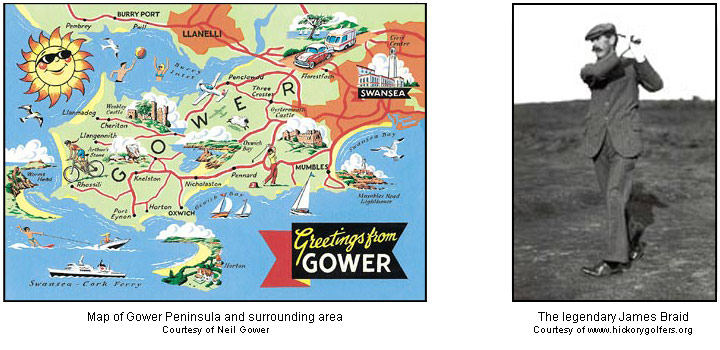
A golf club of sorts has existed at Southgate since 1896, but it wasn’t until the reconstitution of 27 March 1908 that Pennard Golf Club began to take the shape that is recognizable today. During this infant year and while at the height of his fame as one of the Great Triumvirate, James Braid made three visits and designed an 18-hole course, some of which remains today. Although the overall flow of the course has been altered greatly in detail, the broader strokes of the 1908 routing and the three further visits of 1911, 1920 and 1931; make it clear to this author that Braid deserves the lion’s share of credit for Pennard. It is equally clear that significant contributions were made by C.K. Cotton in 1965. Additionally, important alterations were carried out by Fred G. Hawtree in 1920 and Donald Steel in 1991. Interestingly, H.S. Colt was paid to make suggestions for alterations in 1920. Whether or not Braid used some of Colt’s ideas is not known.
Despite its merits, Pennard also has detractors. They point to the limitations of the course: the land is severe, bunkering is light, conditioning is far from ideal, and perhaps worst of all, the course is short and plays shorter still during the summer months. The criticisms are accurate, yet Pennard unabashedly rises above these. After several plays one gains a perspective which reveals the rhyme and reason of Pennard. Along with the West Links of North Berwick, St. Enodoc and Carne, Pennard offers the golfer a balance of challenge, beauty, fun and affordability which is difficult to match anywhere. Pennard is not the “championship” test that other Welsh links such as Harlech, Royal Porthcawl and Conwy are. Rather, Pennard is top drawer holiday golf which can be enjoyed daily by any standard of player. Most links rely on wind to put the back of the golfer in play and Pennard is no different. It can be an awful test when the wind rips up the Bristol Channel and the course is keen. Even so, Pennard is first and foremost a place to enjoy the ups and downs of a friendly game followed by a pint while discussing any topic under the sun.
The flow of the holes are a wonderful tribute to the routing. I am reminded of other Braid gems such as Perranporth and Brora, both of which lead the golfer to ponder what will come next and sometimes cause surprise despite the open vistas. The rugged terrain was maximized by three main techniques. First, on five occasions (first & second, fifth & sixth, seventh & eighth, 13th & 14th, 16th & 17th) the course works into and out of a dead end. Second, three shelf greens (third, 10th & 11th) are cut just below or above the ridges which holes nine and 15 are routed over. In my experience, this technique of using fairways as “backstops” for greens is fairly rare, but can be very effective on hilly sites such as Pennard. Third, and perhaps most important, building the less than perfect blind tee shot 12th makes it possible to utilize a spectacular part of the property for the 13th. The player is then taken back to more conventional ground for the following hole. Tom Doak claims that Alister MacKenzie had a similar difficulty at Royal Melbourne’s West course. He decided to accept a blind drive at the fourth to make other elements of the routing work. Perhaps the good Doctor took a page from Braid’s book!
The course can be divided into four sections. Numbers one through five, are located furthest from the sea and allow the golfer an opportunity to gain a few shots on the card. Holes six through 10, probably the best stretch on the course, are characterized by playing over much of the harshest land in the Pennard Burrows. The following sequence of holes, 11-15, includes three short holes, but all are crafty. This section is the most important for protecting a score because the card doesn’t offer any strokes by way of low indexes and shots can be leaked with niggling regularity. The final three holes provide a grand finish and includes the 16th, perhaps the most memorable hole, and 17, the most controversial hole.
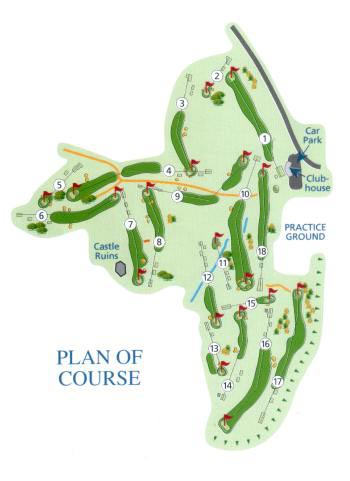
The area to the left of the 13th and the castle is the Pennard Pill
To visit the pro before running through stretching exercises and a quick putt is an age old custom. In a very real sense, every proshop is akin to a bazaar. One never knows what is on offer. When entering Pennard’s proshop the customer is likely to be greeted by Mike Bennett, our congenial and long time Professional. If not behind the counter, Mike can often be found on the range giving lessons or collecting balls. Mike is a local lad who learned the game at Ashburnham, not an hour down the road. His Welsh roots, however, haven’t prohibited Mike from being a disciple of the National Football League (NFL). Mike is a loyal supporter of the San Francisco 49ers and hangs a collection of team caps from the ceiling. If you are looking to haggle over green fees keep this bit of information in mind!
While it is true that none of the opening holes is superlative, it is equally true that any of these holes could be placed on a course with more pedigree than Pennard and not be viewed as inferior. For sure, the fourth must be the pick of the bunch.
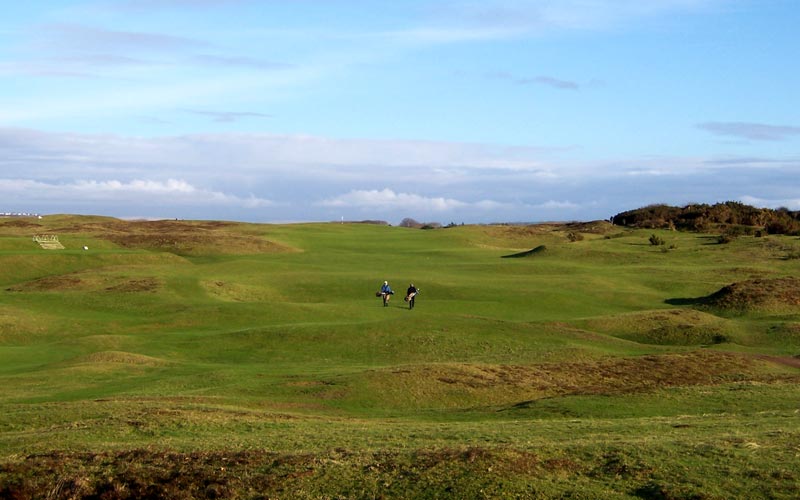
The pleasures of winter golf.
1st hole, 416 yards, FOUNDER: Named in honour of Dr. Edgar Reid, the Founder and Secretary for 28 years. This is essentially a Braid (1920) hole, but CK Cotton (1965) extended the tee by approximately 45 yards. Much later, in 1994, the bank in front of green was leveled to make the approach more predictable.
The opener is a good bunkerless hole which heads straight inland for Swansea. Indeed, many may wonder if this isn’t a peculiar way to start the game when such beauty is at our back. Never mind, the hole requires a long drive down the right side of the fairway to view the pin and a well judged approach to earn a four.
2nd Hole, 145 yards, CEFN BRYN: Welsh for the five mile long sand stone ridge which locals call the backbone of Gower. This CK Cotton (1965) hole is played in the same direction as the old second, but a new green and tee were built.
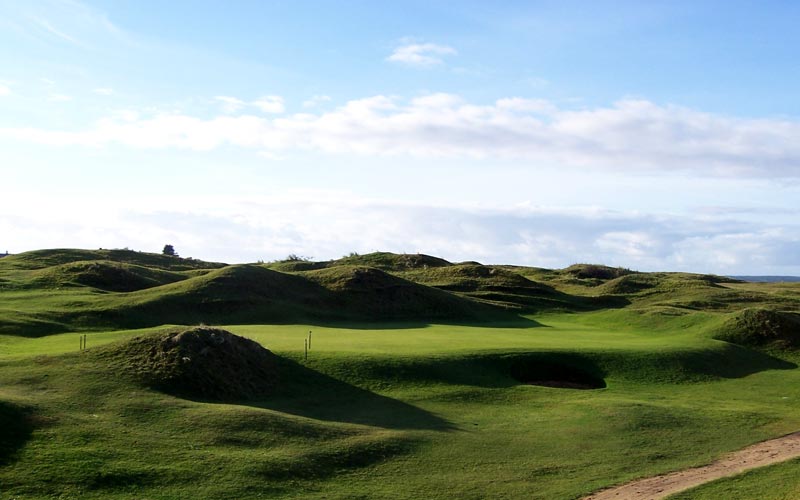
The second green viewed from near the third tee.
The golfer encounters the first of many blind/semi-blind tee shots with all the bunkering hidden. One would think the green gathers because of the partial bowl in which it lies. However, this is not the case. When the wind is off the sea (from the golfer’s left) nothing but a well flighted shot will prevent the ball drifting right. During the summer of 2006 the green was re-laid. Unfortunately it did not take well and the green remained closed during the following winter.
3rd hole, 365 yards, PRESIDENT: Named in honour of Major Tom Morris, President of Pennard in 1965. This is essentially a CK Cotton (1965) hole which may utilize Braid’s 1908 second green. The hole plays in the opposite direction to the old third and is approximately 50 yards longer.
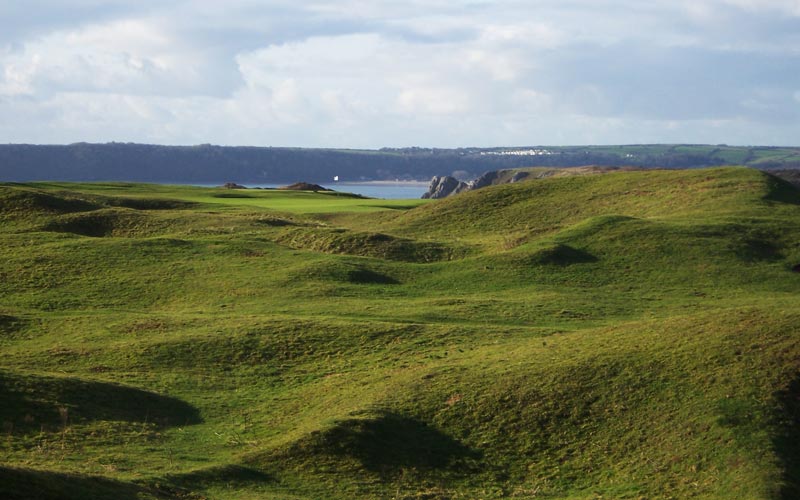
The waves of Pennard.
The golfer is faced with an awkward tee shot to the corner of this nearly 90 degree dogleg which bends around a large dune and a pair of blind bunkers on the left. The flat-belly can take on cutting the corner to huge advantage. The modest golfer must select his club with care as a drive either too short or too long results in a blind approach. If one does place his drive well the view of the green can be described as a flat shelf and not at all a promising target. Club selection is a worry when the hole is cut in its best position on the right of the green. The space between the front and rear bunkers is a mere snip and appears shallower still when the summer shade of green reminds one of mushy peas.
4th hole, 517 yards, ILSTON: A small village located at the head of Bishopton Valley. The village is famous for its church which is said to be the first place of congregation for Baptists in Britain. In 1965 CK Cotton substantially re-routed the fairway which eliminated a sharp dogleg in favour of a tee which makes this hole play fairly straight and directly over the 3rd green. In 1972, the large sandy area near the public footpath was seeded. Donald Steel (1991) further straightened the hole by moving the green some 50 yards back and left of a dune because it was located too close to Brig-y-Don, a bungalow just beyond the hedge. One of the incidents which prompted this alteration involved a Dr. McDonald rummaging through the hedge of Brig-y-Don in search of his ball. The doctor was grabbed by the son of the owner who refused to release him until the police arrived about an hour later!
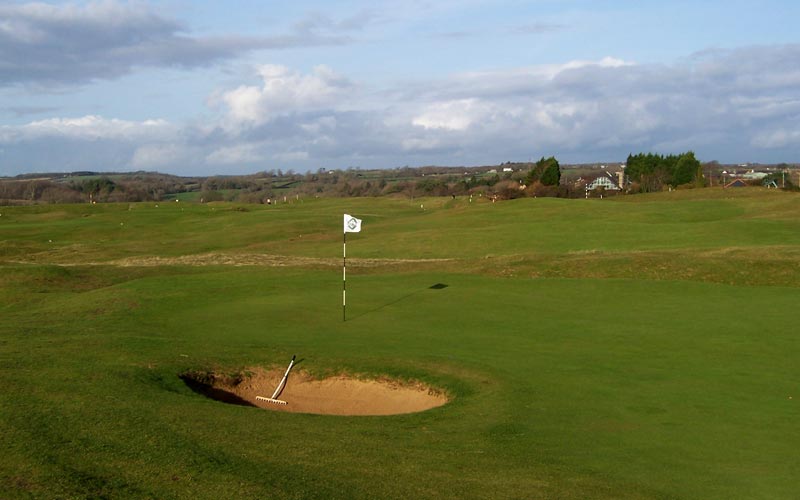
The third green and fourth fairway.
Too often, holes are designed to guide the player to the green. This is certainly not the case with Ilston. The landing zone is very large and not well defined. This may sound like a weakness, but the author believes this openness to be the major strength of the hole because the imaginative player has several lines of attack to choose from. The marker post is there, but it can be difficult to understand why this is the “best line” in a confused landscape. In fact, with modern equipment and a tailwind, the line of the marker is the most dangerous play due to Out of Bounds lurking another 50 yards up the fairway. Perhaps the sight of players on the third and ninth holes combined with walkers heading for the beach causes consternation for some. After a well placed drive near the public footpath the visitor should not be embarrassed to ask where his second should be placed or indeed if the green can’t be reached. The green is nowhere to be seen. What the player can see is a fairway which pitches and rolls and a pair of bunkers just short of a moderate size dune on the right of the fairway. The large green is tucked over the crest of a roll and runs away from the player. Tempting the player to bite off more than he can chew is a critical aspect of good design. When one considers the dodgy lies that can be drawn beyond the green, the fourth meets these temptation criteria as a classic risk/reward hole.
5th hole, 165 yards, PENMAEN: A village on the slopes of Cefyn Bryn with a magical view of Three Cliffs Bay. This hole was built by Steel in 1991 at the same time the 4th was altered. The members thought the green was too severe with the wind at their backs. Consequently, in 1995 the green was reshaped and reprofiled to more easily accommodate aerial shots.
Heading in nearly the same direction (west) as the second, this short hole is greatly affected by wind coming up the Pill, especially as the tee is elevated. The front bunkering makes the tee shot very difficult to a forward hole location. It is best to ignore the pin and aim for the centre of this back-to-front sloping green.
6th hole, 400 yards, ADMIRAL: This hole honours Admiral Sir Algernon Lyons, the well known husband of the first President of Pennard Golf Club, Lady Louisa Lyons. In 1965 CK Cotton moved the green to its current (and brilliant) position a few yards further left and up the hill from Braid’s original 1908 layout.
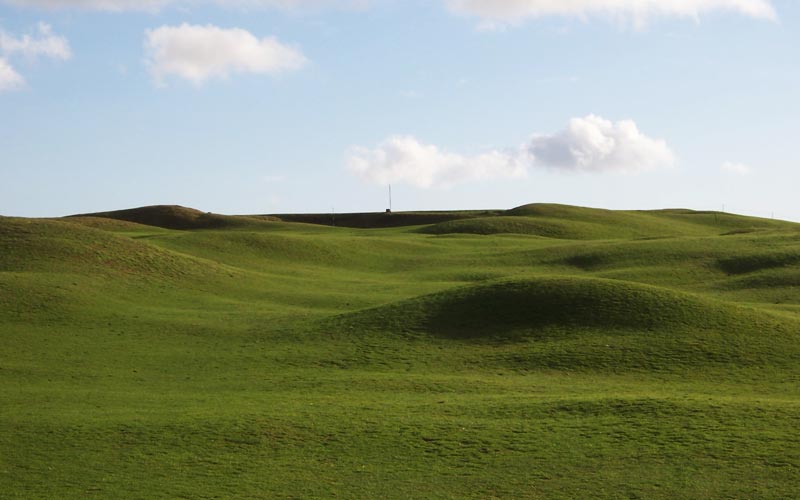
The approach to the sixth.
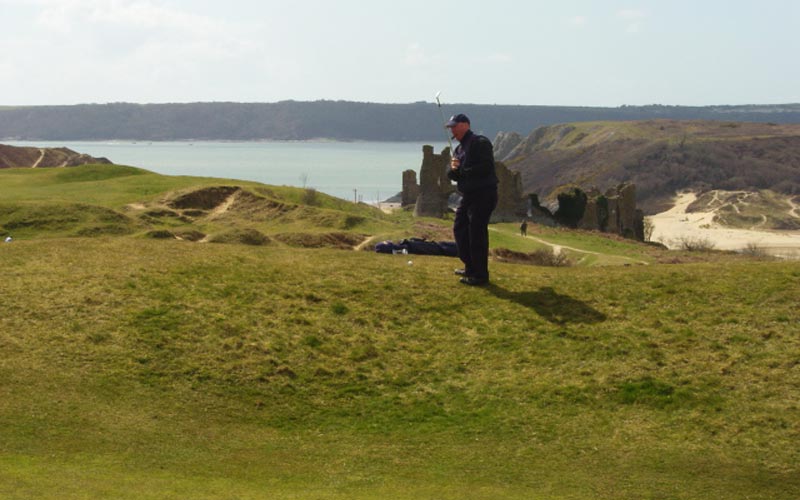
Recovering on the sixth.
For many, Pennard begins in earnest when standing on the sixth tee. The view straight down the Pill with Pennard Castle to the left is alluring. When the golfer does turn his attention to the tee shot at hand he will discover it requires a strong strike up the left in the hope that the ball will spill to the centre of the fairway. That is not to say a bolder player cannot aim right and turn the ball straight toward the hole, but few are brave enough to aim toward trouble. A clear view of the flag is gained if the player manages to pull off one of his best drives of the day. The approach continues the steady climb to a green nestled in a raised bowl. This green differs from other punch bowl greens in that it seems to repel rather than gather balls. This is mainly due to a ridge running left to right about five yards short of the green. Anything less than a bold shot will take the path of least resistance and turn right leaving a delicate pitch over the ridge. Suffice it to say that an approach which carries the green will usually end up at the rear and in the lap of the gods. Admiral is often greatly under-valued, perhaps because of the following hole.
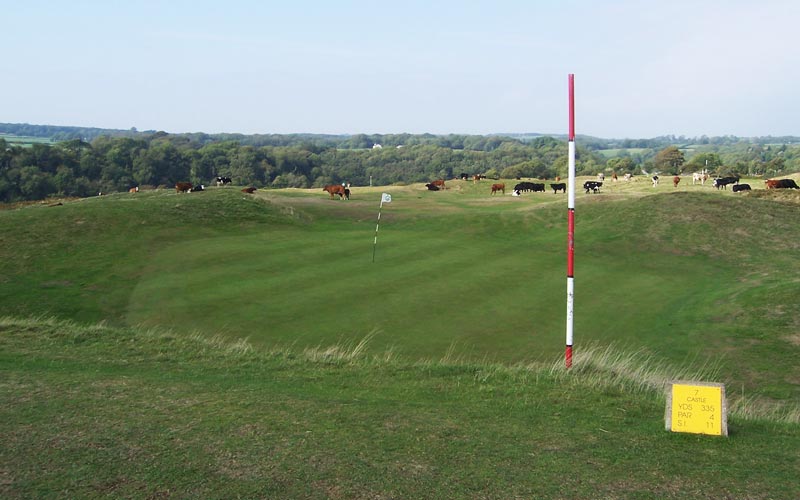
The raised-bowl sixth green viewed from the seventh tee.
7th hole, 351 yards, CASTLE: So far as I can determine, this is a Braid original. The routing and tee are from the 1908 course and the green was rebuilt in 1931. Because the castle is the most enduring symbol of the club, a few words about its origins are in order. The following is paraphrased from P.M. Grant’s 100 Years On The Cliff: The Complete History of Pennard Golf Club.
It is thought that Pennard Castle was built during the reign of Edward 1st, who was known as “Longshanks” and “Hammer of the Scots,” in a continuing effort to subdue the Welsh sometime after 1272. Oliver Cromwell is the last named Lord that held the manor and castle of Pennard. In 1650 Cromwell commissioned a survey of all his lands which reported “There remains but part of the ruins and so unrepaired that there scarcely remaineth one whole wall. ”
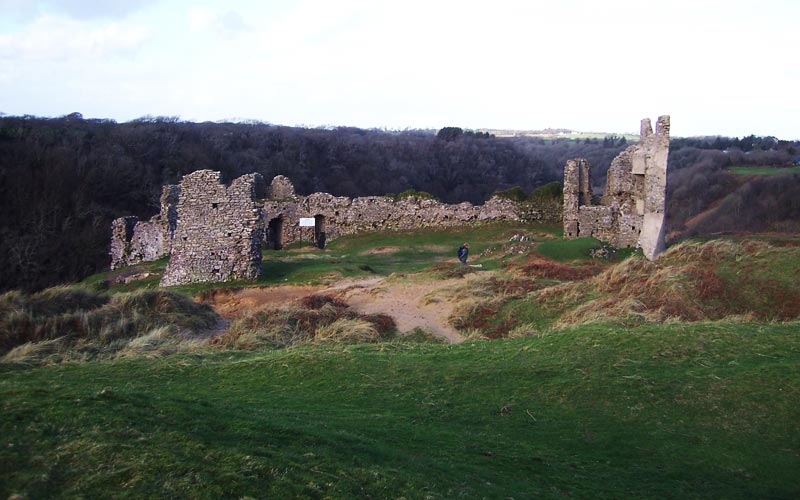
The club became the owners of Pennard Castle in 1920. Admiral Sir Algernon Lyons invested most of his money in Germany and lost it before the start of World War I. Upon his death in 1911 the Kilvrough Estate was left to the Admiral’s eldest son, Thomas Humphrey Lyons to avoid death duties. However, the influenza outbreak of 1918 took his life and, ironically, the estate had to be broken up to pay death duties. Eventually, the club paid £1500 for the land, a bargain born of opportunity if ever there was, and the castle is now listed as a Scheduled Ancient Ruin. For many years the National Trust attempted to purchase the 95 acres of land surrounding the course which included the castle. In 1988 a deal was apparently struck only for negotiations to fall through.
The sand which surrounds the castle used to spread much further around the Pennard Burrows. As such, rabbits were a frightful problem and in 1910 the club agreed to increase the rent payment to Lady Lyons from £10 to £50 per annum if she would rid the burrows of rabbits. After World War I, the professional, Gus Faulkner, father of Max Faulkner, the 1951 Open champion, was given permission to shoot rabbits before 10:00am. Presumably, the members slept late! Despite the four decades of war with the rabbits, the onset of myxomatosis in the 1950s was the eventual reason for their demise. Only after the removal of the rabbits did the character of the course begin the change from a sandy waste to what it is today.
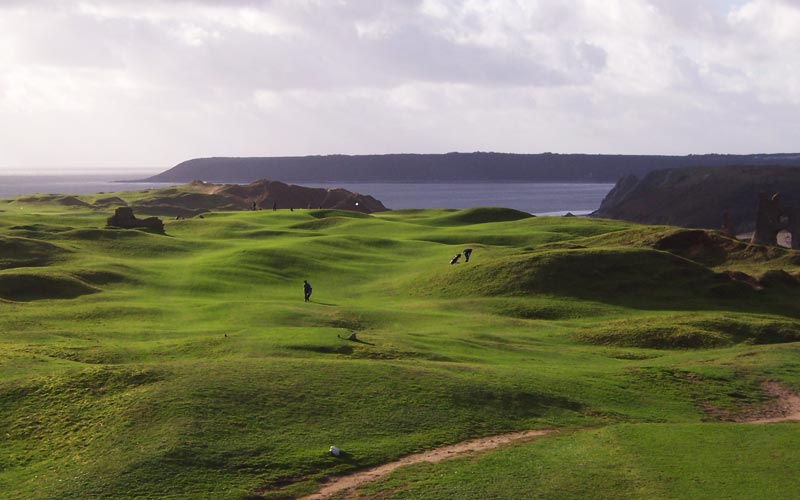
A fine line between church and state!

The brilliantly positioned centreline bunkers which menace the drive and protect the green.
If the 16th isn’t cited as the favourite of most, then Castle usually is. “The line of flight between the sparse ruins of a thirteenth-century church on the left and the more imposing ruins of twelfth-century Pennard Castle on the right presents one of the unforgettable prospects of golf, our drive winging away over a deep chasm to come to rest in a turbulent patch of fairway, with the Bristol Channel shimmering pewter in the distance.” is how James Finegan described the view from the tee. The centreline bunkers perhaps 50 yards short of the green make the approach one not soon forgotten. The green is equally tremendous and epitomizes the concept of defending a course around the greens. It is sited just beyond the crest of a dune then slips sharply away from the fairway. The expectation of a three is not unjustified when the hole is cut in the lower bowl. Four is always a good score when the hole is located on the upper left shelf.
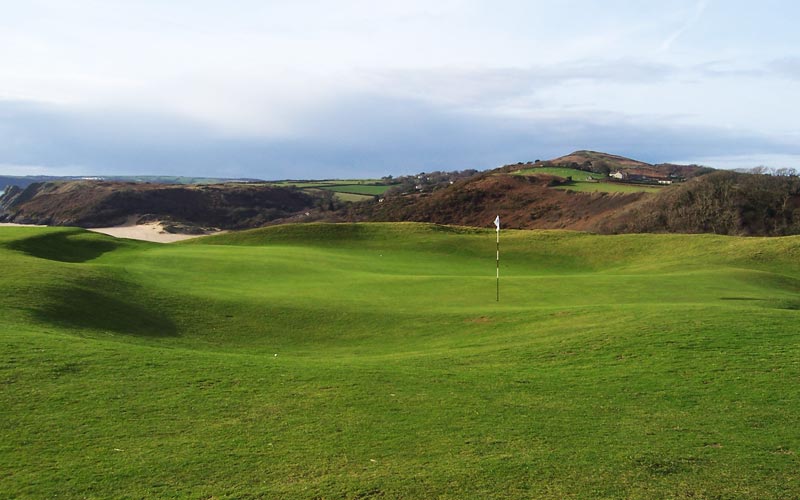
The seventh green was probably Braid
8th hole, 357 yards, CHURCH: St. Mary’s was built around the same time of the castle and is thought to have suffered the same sandy fate, sometime in the early part of the 16th century. Another Braid original, the entire hole probably dates from the 1912 routing.
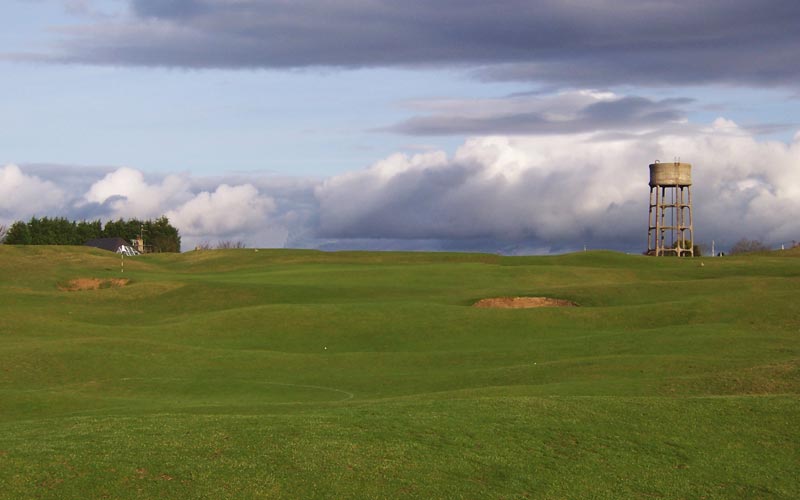
Even with a wedge it can be dangerous to take aim at the left flag.
Church doubles back on the seventh, doglegs slightly left and travels a bit uphill to a tricky green. Both front corners are protected by a bunker, each making hole placements behind these hazards especially troublesome.
9th hole, 445 yards, SOUTHGATE: The village where Pennard G.C. is located. A Braid gem designed in 1920.
The ninth is the last and without doubt the most difficult of an excellent string of two shotters which began at the sixth tee. Like the eighth, Southgate turns left, but with one added element, the land falls right all the way up to the green which is perched on top of a dune well above the fairway floor. The “reverse dogleg” concept works well here because there is enough room to miss right. In fact, it is best to be on the outside of the turn. For those that try to shorten the dogleg, a bunker and a poor angle of attack await.
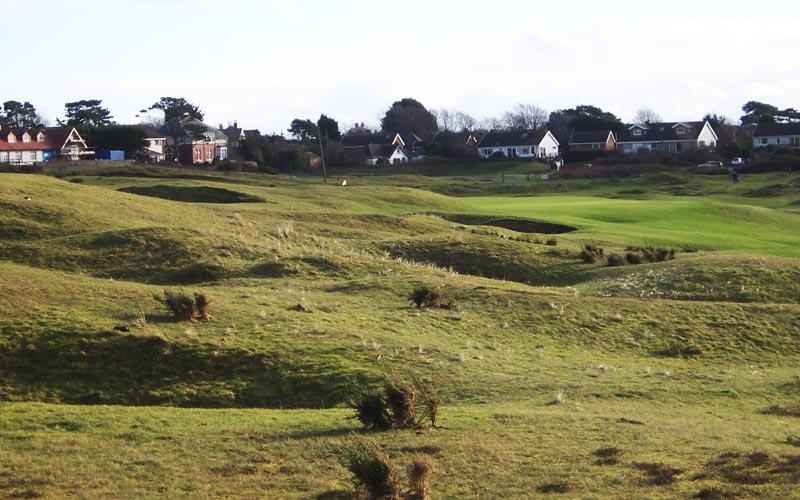
Approaching the ninth from the wrong angle.

The hole opens up from the fairway.
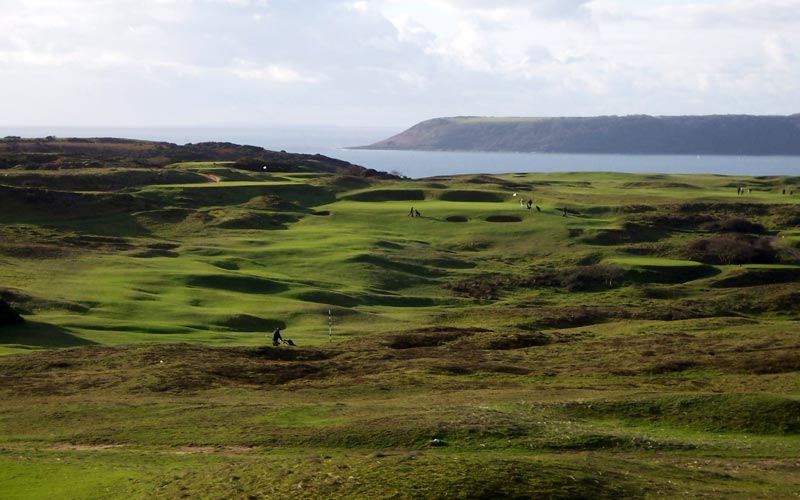
A sneak preview of the 10th from the ninth fairway.
10th hole, 492 yards, THREE CLIFFS: Named for the view in the distant background. In 1965 CK Cotton decided to keep Braid’s tee (1920) and stretch this hole another 80 yards up the hill, just below the 15th. The green was widened and extended further right in 1993 at a cost of £8000. Some thought the green was extended too far and was too costly, but the benefit of additional hole locations proved the investment to be worthwhile.
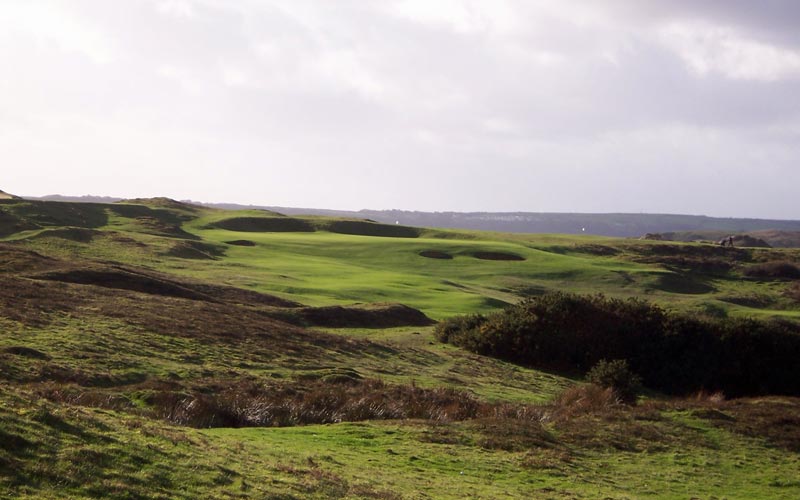
Few consider that laying well up offers the best angle to approach the 10th.
Most golfers are very unsure of which line to take even though a marker clearly shows the way. Pick the right club, hit a draw and one has every chance of turning the corner over the creek which runs under the valley floor where the fairway acts a bridge. The tee shot exemplifies the relative non-importance of yardage at Pennard. The creek is all of 315 yards from the tee, but it is often prudent to lay up. The second shot is as equally uphill as the tee shot was downhill. Bunkers guard both front edges and back left of the green making the short, uphill, semi-blind approach a trifle disconcerting.
11th hole, 180 yards, TOWER: Named for the water tower in the background. This hole is solely attributable to CK Cotton (1965).
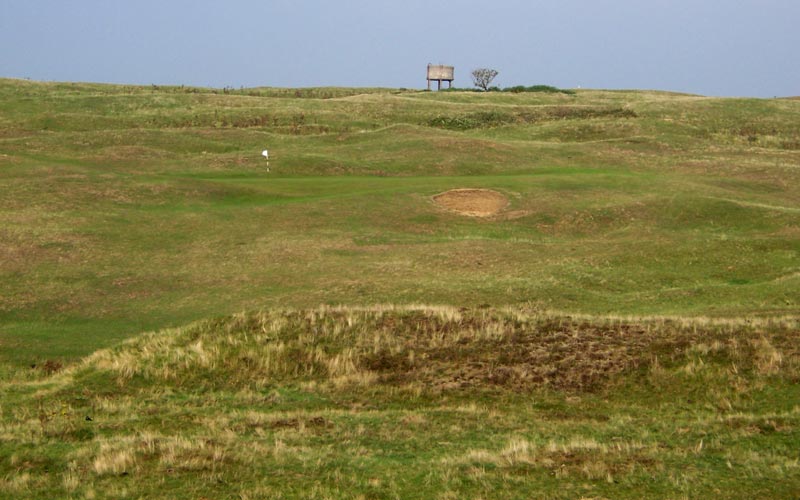
The magnificent 11th hole viewed from the 10th fairway.

A side view of the green showing the severe false front.
Tower is the last of a remarkable run of six holes over some of the most rugged terrain in golf. The 11th is also the start of several holes which, in the words of Donald Steel, “are teasing rather than formidable.” We hit over the same valley as on the 10th, but in the opposite direction. The awfully narrow green is tucked into a hillside below the ninth fairway. The pinnable area is no more than 10 paces wide. The green sports a false front which a can repel a weak approach a full 50 yards back toward the creek. Severe, testing and great are apt descriptions for this hole.
12th hole, 298 yards, PENNARD PILL: Named after the deep stream valley near which the castle stands. The original 1908 Braid green is still in use. The hole used to be played as a very short par four from somewhere short and right of the current 11th green and over the 15th tee. CK Cotton built a new tee in 1965. The fairway was extended toward the Pill in 2005.
James Finegan labels this hole as “marvelous.” Rough used to stop balls from rumbling down the side of the hill and crash landing in the Pill. By widening the fairway Tom Doak’s concept of “short grass as a hazard” became a reality because there is nothing to save the slice from oblivion. Anybody attempting to drive this blind green had better pick the correct line just right of the 15th tee or risk the indignation of earning nil point on Pennard’s shortest two shotter. Of course, laying up and approaching the hole blind is always an option!
13th hole, 207 yards, COLONEL: Named after Colonel Llewellyn Morgan for providing the funds to build Braid’s green in 1908. In 1978 the dune to the front left of the green was reduced rendering the pin visible anywhere on the putting surface.
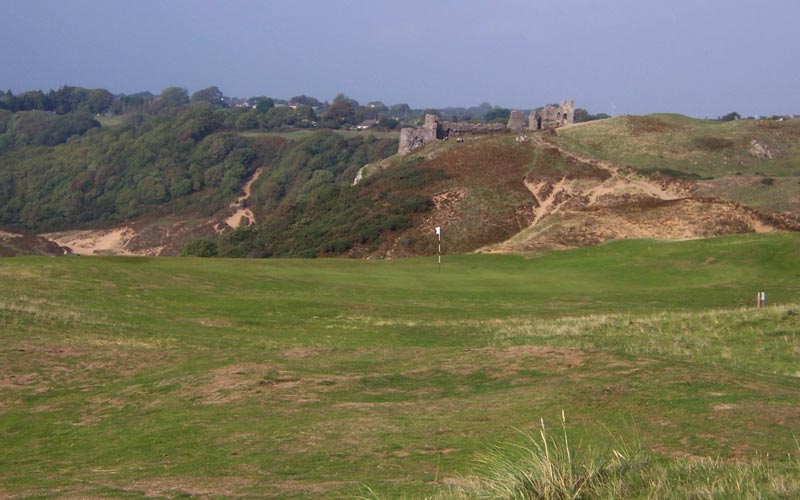
A view of the castle from behind the 13th green.
In the January 1928 issue of Golf Illustrated, Sir Ernest Holderness thought enough of Colonel to name it one of the best in Britain. Like the 11th, this is a knob to knob shot over a valley. It may be wise to aim over the waste area on the left and perhaps take an extra club rather than risk your ball tumbling down the bank to the right of the green; another area where short grass is a hazard. The recovery back up the slope requires a deft touch. Errors in judgment or execution usually result in a bogey or worse.
14th hole, 368 yards, BRAIDS: Braid’s favourite hole at Pennard. Another Braid original (1908); the tee was extended 35 yards in 1984.
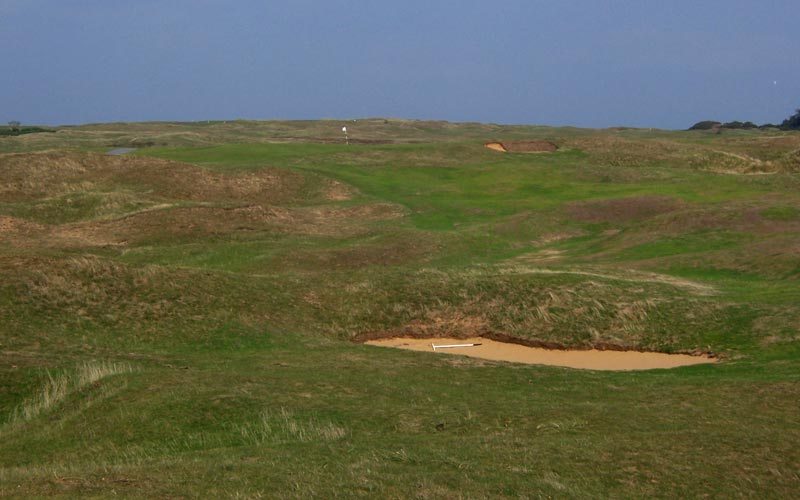
The 14th with Bill
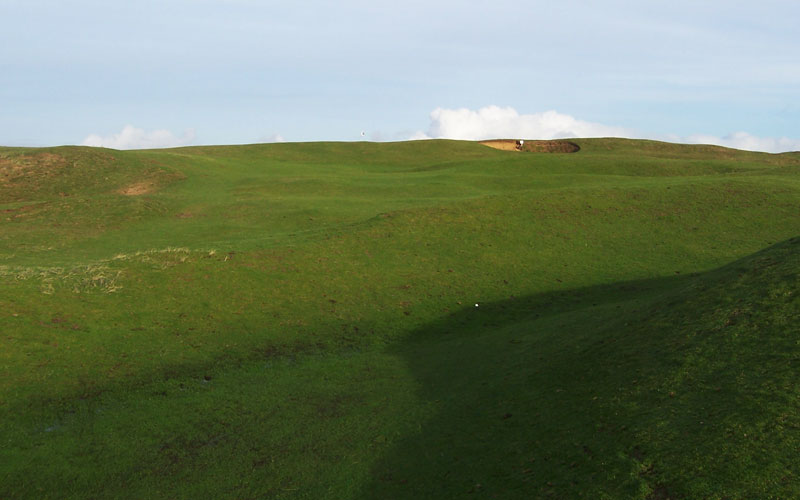
The approach to the 14th demonstrates why Pennard is often called the Links in the Sky.
To borrow from Sir Ernest again, Pennard: A Course with a Great Future was written for a 1926(?) issue of Golf Illustrated. The tee shot for the 14th was described as “a long carry over broken craters of sand and a high pitch shot over a high rampart of sand.” The description sounds accurate except for the mention of sand everywhere! This hole was obviously affected greatly by sand and that is no longer the case. There are but two bunkers. The first, which lies blind at the start of the fairway, is affectionately known by me at least, as Bill’s Bathtub, on account of my mate Bill McBride being the lone person I know to have visited this pit! The second is a large front right greenside bunker which very much influences play. Like Braid, this too is one of my favourite holes at Pennard. The elephant’s graveyard fairway (presumably turfed over sand craters) combined with the rather abrupt uphill second, showcase two essential skills if one is to play well at Pennard: controlling ball trajectory and coping with wonky lies. One final thought before heading to the 15th, take note of the seamless transition between the fairway and green. Many holes at Pennard exhibit this quality, but none better than Braids.
15th hole, 165 yards, BOSCOS DEN: One of the many caves in the Pennard Cliffs. The last of the original Braid holes designed in 1908.
This is the last in a series of short, tricky holes. The 15th is an unusual hole at Pennard for two reasons. First, the hole is relatively flat, the only such hole on the course. Second, the green strikes one as contrived because of the three tiers. A pot bunker rests about half way up the right side of the green and certainly comes into play especially when the hole is cut on the middle or back tier. One interesting feature of the green is that it narrows progressively from front-to-back. This is a good hole despite the obvious touches of man’s hand.
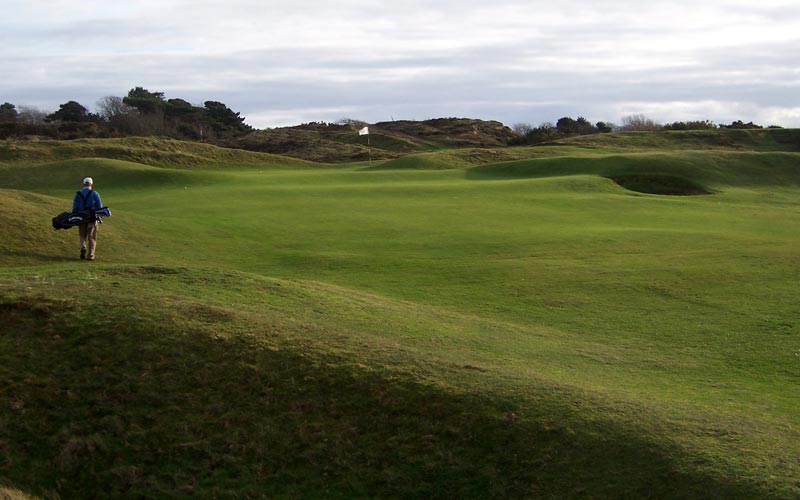
The 15th green viewed from just above the 10th.
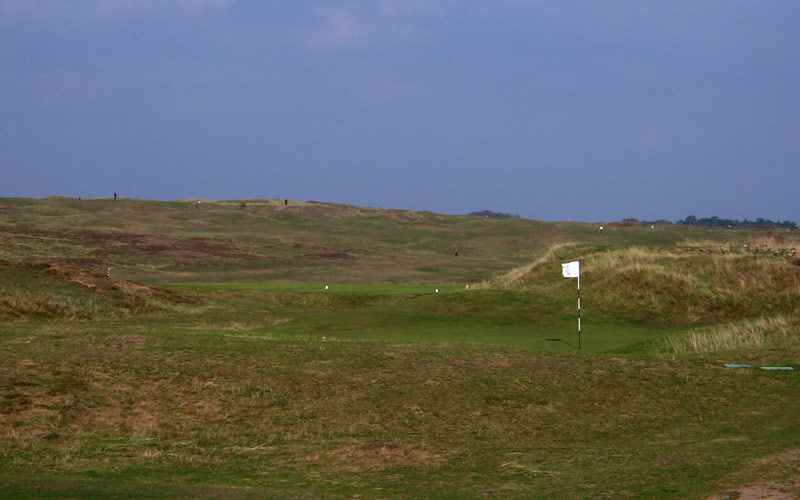
The 15th green viewed near the 16th tee.
The final three holes offer one last look at the sea before turning for home. The drives at holes 17 and 18 are very unusual for Pennard because they feel constrained and are quite penal; only the correct line and/or shape will do and why not?
16th Hole, 493 yards, GREAT TOR: The small headland viewed behind the green. Originally the green was down near the present 17th tee. In 1927 the decision was made to keep the 1908 Braid tee, but move the green about 65 yards further back into the dunes, not far from where the old 17th tee used to be. Braid strongly objected to this alteration, perhaps because it may have included moving the 17th tee from a glorious position and creating another blind drive. The green was extended further right in 1995 to create more hole locations.
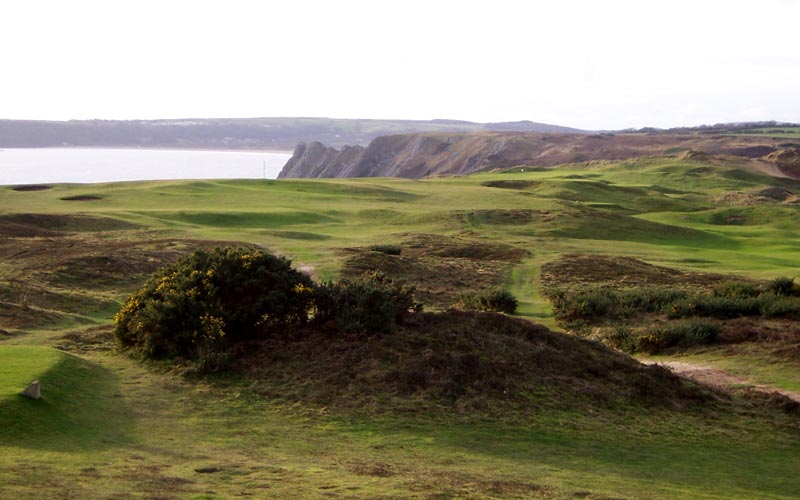
The tee shot at the 16th.
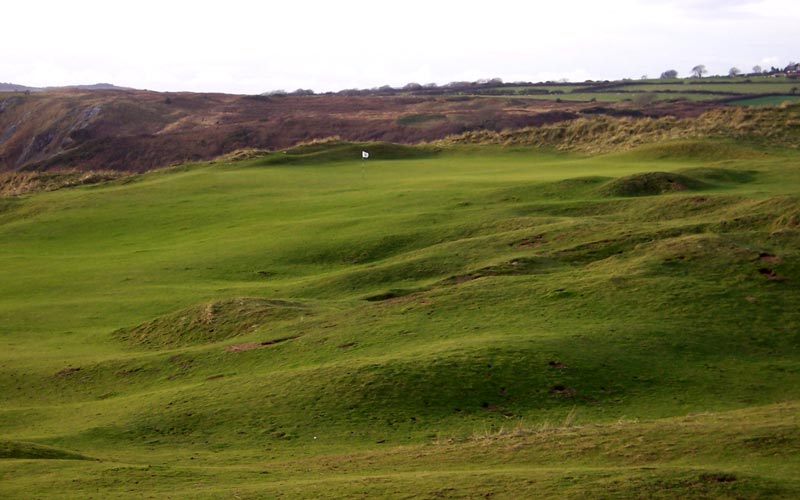
Even from this distance, the 16th green doesn
If Pennard has a signature hole then this is it. I will leave it to James Finegan to describe: “heartstopping panorama of cliffs and beach and Channel “ the drive falling to a typically Pennard fairway ¦the approach rises steeply to a cliff top green that slopes perilously down from back to front, sending many a lag from above the hole, when the greens are skittish, down into the fairway.”
17th Hole, 488 yards, HELWICKS: I believe the name derives from the Helwick Bank; a large sand bank between Port Eynon and Worms Head. It isn’t known who is responsible for the current tee position, but Braid (1908) is responsible for the general routing and Hawtree (1920) for the green.
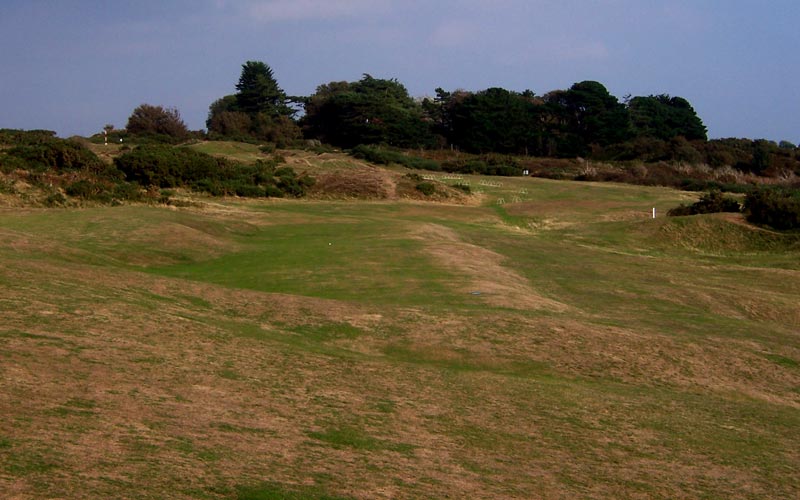
This is what the player cannot see when driving on the 17th.

The risky option of going for the green in two.
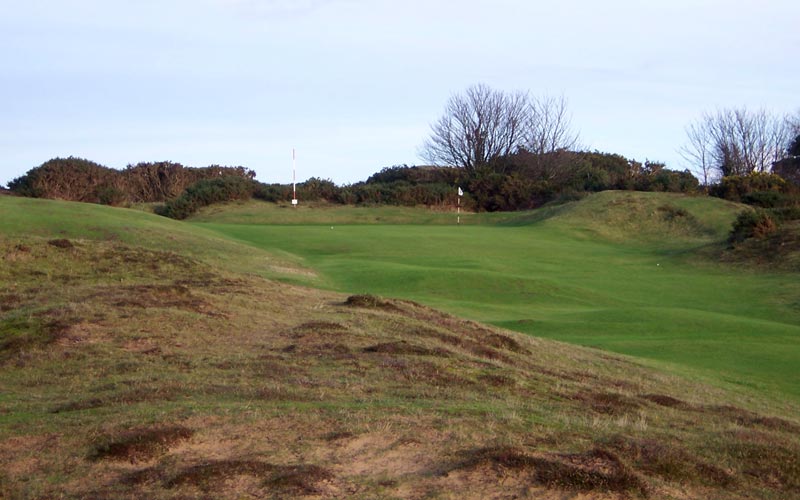
A closer look at the 17th green.
It is surprising; to me at least, that Sir Ernest Holderness selected this hole in addition to Colonel as one of his favourites in Britain. Many great courses have at least one highly controversial hole and surely Helwicks fills that role at Pennard. The 17th presents three main difficulties. First, the tee shot is blind. Not at all a bad thing if it weren’t for the second problem; the hill takes nearly every shot straight right. To alleviate this sporty element a rather clumsy attempt was made at leveling a section of the fairway in 1984. Additionally, the heavy gorse down the right of the fairway is periodically cleared to widen the fairway corridor. For the most part, these remedies have been successful. The final piece of the puzzle is the awkward lay-up beyond the dogleg because of the exceedingly narrow fairway. Despite, or perhaps because of these faults, I am gradually taking to the hole. I always look forward to the opportunity of going for this green in two. It’s a foolish play I know, but temptation gets the better of me on most visits.
18th hole, 415 yards, HIGHWAY: Presumably named for the road leading to the course. This hole used to play blind over a large sandy area (down the right side of the current 18th fairway) which later became the practice the ground. In 1971 a new tee straightened the hole down to the Hawtree green (1920). In 1989 a large dune in front of the ladies tee was topped to make the fairway visible.
If the golfer has experienced a trying time on the links the playful nature of the ponies often grazing near the front of the tee is a welcome distraction. This last hole is unique for Pennard because the tee shot calls for a fade to work into the left sloping fairway. Like the penultimate hole, Highway is a bunkerless hole, but it is well defended by severe rough and heather up the left. The second shot is one of the more straightforward approaches on the course, but it is a satisfying finish nonetheless.

The home hole.
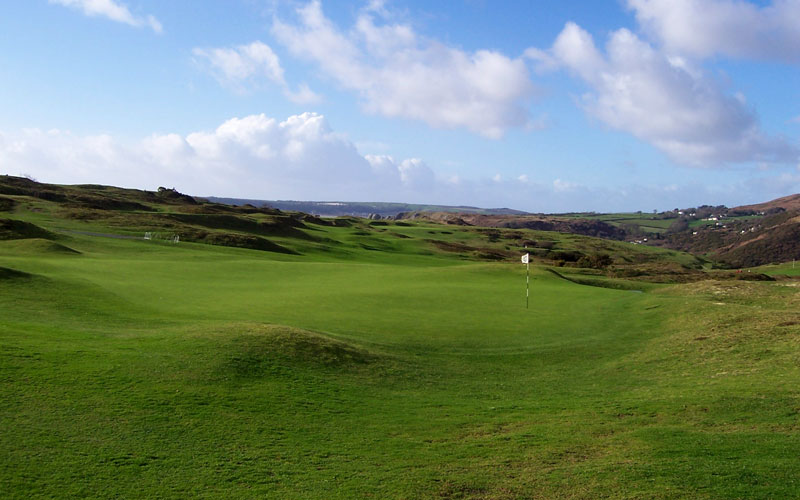
The 18th green from the rear “ the 10th hole is in the middle background.
Just as most games begin at the proshop, it is also the case that many golfers wouldn’t consider the day complete without repairing to the clubhouse to settle debts while taking ale. The clubhouse is fairly new, but in no way ostentatious. The most inviting room is the spike bar, located, unusually, on the 1st floor. Much to the visiting Englishman’s chagrin and true to the traditions of South Wales, rugby, rather than football, is the sport of choice for post golf viewing. The spike bar is however, cheery and comfortable no matter what is on the telly.
That then is Pennard, short on yardage, but long on character. The same cranky, undulating land which creates sporty bounces is also responsible for Pennard’s greatest asset, shot making options. These options combined with continuously changing weather mean the course will never become too familiar. Is this variety not the very definition of a great course? Tom Doak proclaimed Pennard to be one of his “all-time favorites.” Max Faulkner thought it the best course in Britain. James Finegan held nothing back when he exclaimed “I see no reason to back away from an unflinching conclusion: Pennard is a very great course, in my experience one of the twenty greatest in the world.” I can only add that Pennard is a course to savour not over-analyse.
ACKNOWLEDGEMENTS
Many thanks to www.neilgower.com , www.hickorygolfers.org, www.pennardgolfclub.com and Philip Gawith for their generosity in granting permission for the use of their images. I am grateful to my beautiful wife, Julia, who often dips from her well of patience on my behalf. A word of appreciation to Chris Clouser, Philip Young, Tom Doak and Jim Thompson for taking the time to respond to my pleas of help. Most of all, though, I must thank my editor-in-chief extraordinaire, Mark Rowlinson, whose efforts far surpassed what was asked of him.
REFERENCES
Tom Doak: The Confidential Guide to Golf Courses 1996 edition page 271
For a further explanation of short grass as a hazard see http://doakgolf.com/essays.asp?e=besthazards
For information on the Gower see www.explore-gower.co.uk
James W. Finegan: All Courses Great and Small “ A Golfer’s Pilgrimage to England and Wales
2003 edition pages 268-270
P.M. Grant: 100 Years On The Cliff “ The Complete History of Pennard Golf Club
1995 edition pages 12-13 & 26-57
Sir Ernest Holderness: Golf Illustrated “ January 1928
Sir Ernest Holderness: Golf Illustrated “ 1926(?) A Course With a Great Future
Donald Steel: Classic Golf Links of Great Britain and Ireland 1992 edition pages 152-153
The End

